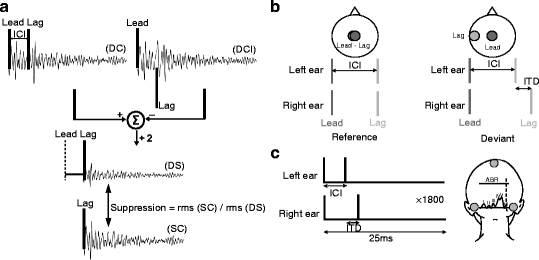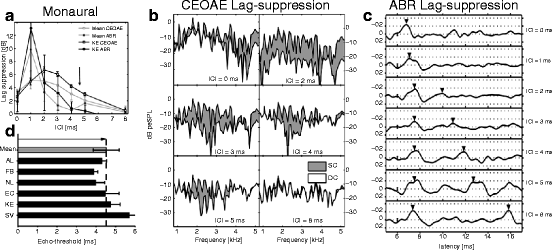(32.1)
with parameters n = 4, φ = π/2 and a = 1, b = 1.018, leads to a basilar-membrane impulse response (BM IR) description for the human auditory filter. The BM IR durations (i.e., the time until the amplitude reduced by 95 %) calculated from Eq. 32.1 are 18.7, 11.6, and 7.1 ms for frequencies of 1, 2, and 4 kHz, respectively. It is thus expected that BM IRs to clicks that are separated by only several ms will overlap in time. Indeed, already in 1969, Goblick and Pfeiffer observed BM IR interactions in the firing pattern of cochlear nerve fibers in cat in response to temporally spaced acoustical clicks. They described their observations in terms of two systems: an instantaneous compression mechanism and an unknown dynamic compression process.
The present study aimed at characterizing human BM IR interactions noninvasively by using click-evoked otoacoustic emissions (CEOAEs) and auditory brainstem responses (ABRs). Individual correlations between the objective measures and the perception of monaural click pairs were performed to determine the contribution of BM IR interactions to the percept of fusion, i.e., the inability to hear out the second click in a click pair (Litovsky et al. 1999). Secondly, the influence of monaural BM IR interactions on the perception of binaural click pairs, known to lead to the perception of the precedence effect (e.g., Wallach et al. 1949; Litovsky et al. 1999), was investigated.
2 Materials and Methods
Six normal-hearing subjects with audibility thresholds below 20 dB HL (3 females and 3 males), aged between 24 and 34 yrs, participated in the experiments. All experiments were performed in a double-walled soundproof booth. The 83-μs-long clicks were generated digitally in Matlab with a sampling rate of 48 kHz and were presented over ER-2 earphones (CEOAE and ABR) or Sennheiser HD580 headphones (psychoacoustics). In the left ear, click-pair stimuli were presented at 65 dB peSPL (CEOAE) or 75 dB peSPL (ABR, psychoacoustics) for 7 different inter-click intervals (ICI): 0, 1, 2, 3, 4, 5, and 8 ms. In the right ear, the delay between the clicks corresponded to the ICI in the left ear plus an interaural time difference (ITD) of 300 μs (Fig. 32.1c). The ear-canal recordings were performed binaurally for the CEOAE recordings and both monaurally (L,R) and binaurally for the ABR and psychoacoustical experiments.


Fig. 32.1
(a) Method for obtaining lag suppression in the CEOAE recordings. The stimuli were presented using an interleaved procedure: for each ICI and ITD condition, 1,800 repetitions of the following three stimuli were presented – single click (SC), double click (DC; two condensation clicks), and double click inverted (DCI; one condensation and one rarefaction click). The CEOAE recorded to a DC stimulus contains a CEOAE to the leading click, a CEOAE to the lagging click, and a nonlinear component due to the ICI. To remove the CEOAE to the leading click while maintaining the CEOAE to the lagging click, a derived-suppressed response (DS) was obtained by subtracting the DCI response from the DC response and halving the result (Fig. 1A; Kemp and Chum 1980; Kapadia and Lutman, 2000a, b; Verhulst et al. 2011a). (b) Lead-lag click pairs used for the psychoacoustical and objective experiments. For ICIs above the echo-threshold, the reference stimulus leads to a centered percept of two separate clicks, whereas the deviant stimulus leads to a laterized percept to the left for the second click. (c) Stimulus configuration for the ABR recordings and visualization of the placement of the Cz, M1, and M2 electrodes
Stimulus presentation and data acquisition for the CEOAE recordings were described in Verhulst et al. (2011a). CEOAE lag suppression was calculated as the rms level difference between the derived-suppressed (DS) and single-click (SC) responses in a time frame of 6–18 ms after the onset of the lagging click (see Fig. 32.1b for procedure). The ABR wave-Vs were recorded as described in Bianchi et al. (2013) (Fig. 32.1c). ABR lag suppression was calculated as the wave-V amplitude difference (in dB) in response to the second and the first clicks.
The psychoacoustical echo-threshold (i.e., the smallest ICI at which two separate clicks were perceived) was determined using an adaptive one-interval, two-alternative forced choice (2AFC) procedure. Each trial consisted of a reference and a deviant (Fig. 32.1b) and the subjects indicated whether they perceived one single click (fused image) or two separate clicks (lead and lag). The starting value of the ICI was 1 ms. After each “single-click response,” the ICI was increased, and after each “two-click response,” the ICI was decreased. The initial step size was 1 ms and was reduced to 0.5 and 0.3 ms as the threshold was approached. The echo-threshold was obtained after six reversals and corresponded to the 70.7 % point on the psychometric function. Thresholds were obtained as the average of three repeated experimental runs. Additional experiments investigating the laterization of the click pairs used here were performed in Bianchi et al. (2013) for the same subjects.
3 Results
3.1 Monaural BM IR Interactions
Monaural lag suppression, representing the level difference between the CEOAE to a single click (SC) and the lag CEOAE derived from the CEOAE to a lead-lag click pair (DS; see Fig. 32.1a), is shown in Fig. 32.2a as the mean over six subjects. Lag suppression was observed for ICIs up to 8 ms. Maximal suppression with individual levels up to 10 dB was found for ICIs of 1–2 ms, in agreement with earlier studies (Kapadia and Lutman 2000b; Verhulst et al. 2011a). These results demonstrate that the CEOAE to the lagging click in a double-click pair is suppressed with respect to the leading click if the ICI between the lead-lag pair is below 8 ms. Individual results for subject KE were also indicated in panel A, as for this subject, a detailed comparison across methods is shown in panels b and c.


Fig. 32.2
(a) Mean and individual levels of monaural lag suppression obtained from CEOAE and ABR recordings. (b) Single-click CEOAE (6–20 ms window) spectra for subject KE, overlaid with derived-suppressed CEOAE spectra for different ICI conditions. The noise floor on these recordings is situated around −30 dB peSPL. (c) Recorded ABR waveforms to monaural click pairs with varying ICI for subject KE. Wave-Vs are indicated with triangles. (d) Monaural echo-threshold obtained from monaural stimulation with the reference click pairs in Fig. 32.1b. For ICIs below the threshold, a fused single-click percept was reported for all subjects
The forward traveling wave to a click excites the whole BM, yet the broadband CEOAE only contains information about local BM processing at those locations where reflections were generated. These locations are observed as components in the CEOAE spectrum, with the strength, number, and frequencies being subject dependent and resulting from the individual BM irregularity pattern (Sisto and Moleti 2008; Shera and Guinan 2007). Figure 32.2b shows a CEOAE spectrum to a single click (i.e., the gray area under SC in all panels) for subject KE, reflecting the broadband nature of the emission. Overlaid in each panel are the spectra of the CEOAE to the lagging click (i.e., the white area under DS) for several ICI conditions. For ICIs up to 2 ms, lag suppression affects all components in the CEOAE spectrum equally, but for larger ICIs, a release from suppression is observed. This release from suppression affects the higher frequencies first as the ICI increases. For an ICI of 5 ms, low-frequency components in the CEOAE are still suppressed, whereas the higher-frequency components show a release from suppression. The frequency dependence of the release from suppression provides a link between CEOAE lag suppression and the local BM IR duration (Verhulst et al. 2011b). Even though it is unclear which exact local BM mechanism is responsible for lag suppression exceeding 6 dB at ICIs larger than zero, BM models based on instantaneous compression can account for the ICI range and frequency dependence of the lag suppression (Kapadia and Lutman 2000a; Harte et al. 2005; Verhulst et al. 2011b).
The CEOAE lag-suppression results in Fig. 32.2a and b have demonstrated that the amplitude of specific components in the CEOAE to the second click is reduced after the presentation of an earlier click. As CEOAEs predominantly originate from reflections of the forward traveling wave to place-fixed BM irregularities (Zweig and Shera 1995; Shera and Guinan 1999, 2007), it is inferred that these CEOAE amplitude reductions reflect gain reductions in local BM processing. Consequently, there should be correlates of this gain reduction caused by presenting two temporally spaced clicks along the ascending auditory pathway. Figure 32.2c confirms this by showing monaurally recorded ABR waveforms evoked by the reference stimulus in Fig. 32.1b as a function of increasing ICI. Two wave-V components are evoked and reflect activity from the superior olivary complex (indicated with downward pointing triangles; Picton 2011). Whereas the amplitude of the wave-V to the leading click is constant with ICI, the amplitude of the second wave-V increases as the ICI increases. The level difference between the amplitude of wave-V to the leading and the lagging clicks reflects ABR lag suppression and is shown in Fig. 32.2a for subject KE. ABR lag suppression was maximal for an ICI of 1 ms and decreased with increasing ICI. The ICI range of lag suppression was somewhat shorter than the range observed for CEOAE lag suppression, with maximal levels that were up to 5 dB higher for ABR than for CEOAE lag suppression. Even though there may be effects related to inner-hair-cell (IHC) processing and across-channel synchrony that are reflected in ABR lag suppression but not in CEOAE lag suppression, both objective measures exhibit substantial amounts of suppression for ICIs less than 4 ms.
Stay updated, free articles. Join our Telegram channel

Full access? Get Clinical Tree


